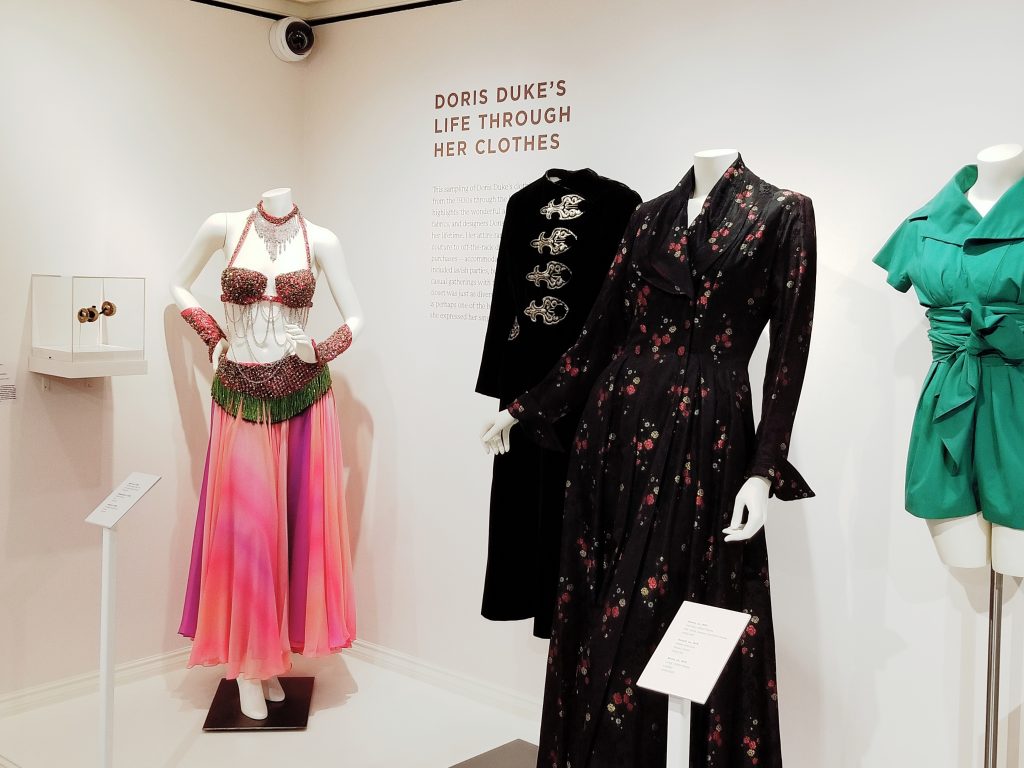
Who was Doris Duke? The tobacco heiress died at age 80 in 1993, and her Newport home Rough Point continues to attract tourists parading Bellevue Avenue.
Since her death, her neighborhood has been protected, kept pristine, by the Newport Restoration Foundation, which Duke founded in 1968.
This is the basic, most locally relevant tidbit of the official story, one now expanded with Rough Point’s exhibit for its 2019 season. Duke also funded black colleges and Russian studies in times of red scare and civil rights struggles. During World War II, she worked undercover as a news correspondent in Italy. She wore many fabulous outfits, and clearly had good taste. Yet most images that survive of Duke were taken by paparazzi.
I wouldn’t have known any of that, if not for attending Monday evening’s preview event for “Beyond Fortune: The Life and Legacy of Doris Duke,” now on view at Rough Point Museum. Curator Kristen Costa said she’s been organizing shows at Duke’s famous digs for a decade, but this is the first exhibit with a truly biographical scope.
“This is really just her and her life story … . People might hear her name, but they may not know anything about her,” Costa said. “She was a woman with money that kind of did what she wanted. It’s a little problematic sometimes, but she is who she is.”
Past exhibits have shown Duke’s globetrotting, her “sporty style,” and Islamic art imported from her (other) mansion in Honolulu. One memorable exhibit in 2015 balanced Duke’s own attempts at teacup repair with contemporary ceramic art spanning from Boston to China. This year’s season returns to Rough Point’s leading lady herself.
“It’s an honest look without glossing over any details,” Costa said.
Important corrections are made, like one concerning Duke’s pet camels, Baby and Princess. Wikipedia maintains they were a gift from a Saudi Arabian arms dealer, but here the truth emerges: the camels came from the less-glamorous-sounding upstate New York. Small moments of humor like this abound, such as a paragraph explaining Duke’s many lovers that begins: “In addition to her official marriages …”
The presentation doesn’t depart from serious matters, like the story of Bernard Lafferty, the butler who assisted Duke in her final years until her death. His treatment is left open-ended, the wall text explaining that, ”[It’s] difficult to know the extent to which Lafferty affected her life.”
At the same time, a photocopied ledger enumerates Duke’s philanthropic contributions to the dollar. Indeed, central to this show is the idea that, while Duke was absurdly rich, she donated often and generously to numerous causes, many of which would be considered progressive even today.
Philanthropy aside, a socialite’s retrospective would be incomplete without some closets thrown wide open. Viewers are treated to a wide sampler of Duke’s outfits, from occasions dressy to highly specific (belly dancing).
“Because we have a huge fashion collection of Doris’s, it was another way to show off her life through her things,” Costa said.
Duke’s “things” are one of the few means available to better understand her, given the gossipy nature of books on her life.
“The works that document Doris Duke tend to be sensationalist and they lack any sort of serious study,” Erik Greenberg, the new director of museums for the Newport Restoration Foundation, said in his opening remarks at the preview reception.
But was Duke targeted more than any other wealthy scion? Isn’t extreme wealth sensational in and of itself? Duke’s destiny was de facto public; she was born with the nickname “the richest little girl in the world.” When she died, the New York Times clung to that lifelong narrative. The paper’s obit sported a weirdly moralistic headline, declaring Duke an “Heiress Whose Great Wealth Couldn’t Buy Happiness.”
Duke predated our Kardashian Epoch, in which the rich and famous have opened up their lives into vistas of pettiness. She was a private woman. Should her want for quiet stretch past her death? What would she think of Rough Point’s annual show-and-tells of her stuff?
“I often wonder: when she left all this stuff, did she think, ‘My dresses are gonna be on display’?” Costa said. “If she was alive now … I don’t know, she might just think, ‘Why do people think I’m so interesting?’”
Would Duke think there are better things to do than gawk at other people’s possessions? I admit I couldn’t help but linger at a painting she won at auction in 1971, displayed at Rough Point though unrelated to the exhibit. Ferdinand Bol’s “Portrait of a Young Girl” is obviously marvelous, but I wonder what specifically caught Duke’s eye. The clutched handful of blue gown? The painter’s mastery of lighting, or the woman’s pearl bangles? Maybe it’s the way she stares at us, eyes all ambiguity, pushing her hair back gently, revealing only what she chooses.
-30-
Reprinted from Newport Daily News (April 4, 2019 edition)
Syndicated in Providence Journal (April 17, 2019)
Editor: Janine Weisman